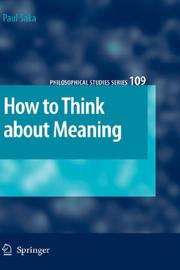| Listing 1 - 2 of 2 |
Sort by
|
Book
ISBN: 9781402083075 9781402083082 9789048119592 9789400705326 Year: 2010 Publisher: Dordrecht Springer Netherlands
Abstract | Keywords | Export | Availability | Bookmark
 Loading...
Loading...Choose an application
- Reference Manager
- EndNote
- RefWorks (Direct export to RefWorks)
Linking - how semantic arguments map to the syntax - is one of the challenges for theories of the syntax-semantics interface. In this new approach, Janet Randall explores the hypothesis that the positions of syntactic arguments are strictly determined by lexical argument geometry. Yielding novel - if sometimes surprising - conclusions, her Isomorphic Linking Hypothesis establishes the linking patterns of a wide range of verbs and, with those results, shows how to reason "backwards" from how a given verb's arguments link to what its lexical representation must be. Along the way, the investigation takes on thorny lexical issues - reformulating the Theta Criterion, revisiting the multiple lexical-entry debate, eliminating "indirect" arguments and redefining unaccusativity. It offers new insights into how arguments are represented, assembles a host of argument/adjunct diagnostics, and re-examines the relation between arguments and predicates. The result of this incisive study is a simple and consistent account of linking, integrated with a radical rethinking of the nature of arguments and argument structure. From the reviews: "Janet Randall's Linking: The Geometry of Argument Structure, is an authoritative journey through a minefield of critical problems. Arguing a symmetry between conceptual structure and argument structure, it will richly reward those readers who do themselves the favor of taking the trip." (Samuel Jay Keyser, Professor Emeritus, MIT) "In this book, Janet Randall, building on much recent research, develops her own version of a geometrical theory of the lexicon and explores a restrictive hypothesis on how lexical entries project into syntactic structure, based on structure preservation. Even those who, like myself, are not so inclined to think of word meaning in geometric terms, will find in this book a striking series of puzzles, challenges, and insights." (Gennaro Chierchia, Haas Foundations Professor of Linguistics, Harvard University) "Janet Randall's book is a model of how to reason across the interface between conceptual structure and syntax. It is a goldmine of razor sharp observations about argument structure and morphology. Each theoretical step is supported by carefully developed empirical evidence. It will be a lasting accomplishment at both the theoretical and empirical level." (Tom Roeper, University of Massachusetts, Amherst)
Logic --- Lexicology. Semantics --- Philosophy of language --- Language and logic. --- Semantics (Philosophy). --- Semantics.

ISBN: 9781402058578 9781402058561 Year: 2007 Publisher: New York Springer
Abstract | Keywords | Export | Availability | Bookmark
 Loading...
Loading...Choose an application
- Reference Manager
- EndNote
- RefWorks (Direct export to RefWorks)
According to the dominant theory of meaning, truth-conditional semantics, to explain the meaning of a statement is to specify the conditions necessary and sufficient for its truth. Classical truth-conditional semantics is coming under increasing attack, however, from contextualists and inferentialists, who agree that meaning is located in the mind. How to Think about Meaning develops an even more radical mentalist semantics, which it does by shifting the object of semantic inquiry. Whereas for classical semantics the object of analysis is an abstract sentence or utterance such as "Grass is green," for attitudinal semantics the object of inquiry is a propositional attitude such as "Speaker so-and-so thinks grass is green." Explicit relativization to some speaker S allows for semantic theory then to make contact with psychology, sociology, historical linguistics, and other empirical disciplines. The attitudinal approach is motivated both by theoretical considerations and by its practical success in dealing with recalcitrant phenomena in the theory of meaning. These include: presuppositions as found in hate speech, and more generally the connotative force of evaluative language; the problem of how to represent ambiguity; quotation and the use-mention distinction; and the liar paradox, which appears to contradict truth-based semantics. "Technically exact, highly readable, and illustrated with valuable examples, ...here is a book to counterbalance decades of misdirected anti-psychologistic semantic dogma." Prof. Dale Jacquette, Pennsylvania State University, U.S.A.
pragmatisme --- filosofie --- Metaphysics --- metafysica --- taalfilosofie --- Lexicology. Semantics --- semantiek --- Philosophy of language --- metaphysics --- Philosophy --- Meaning (Philosophy). --- Reference (Linguistics). --- Semantics. --- Meaning (Philosophy) --- Reference (Linguistics) --- Semantics --- Formal semantics --- Semasiology --- Semiology (Semantics) --- Comparative linguistics --- Information theory --- Language and languages --- Lexicology --- Meaning (Psychology) --- Signification (Linguistics) --- Linguistics --- Onomasiology --- Semantics (Philosophy)
| Listing 1 - 2 of 2 |
Sort by
|

 Search
Search Feedback
Feedback About
About Help
Help News
News